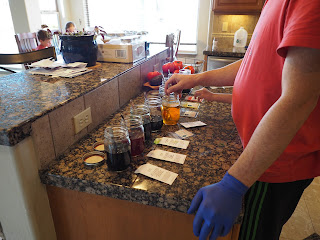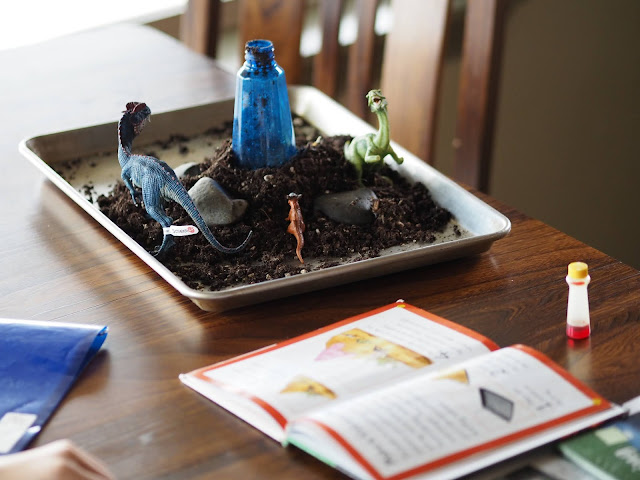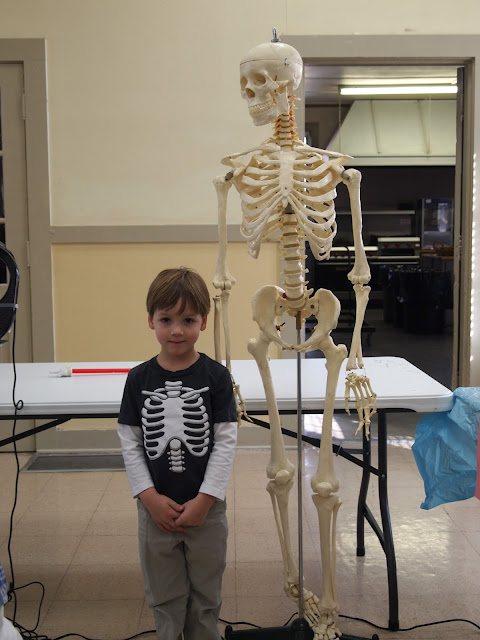Science
Simple Machines
My orb weaver
Office Supply Grappling Hook
Museum of Natural History, LA
Investigating lava flow at Paulina Peak
Aspen trees near the 2nd Largest Organsim on Earth, Pando
Volcanoes are so much more fun with dinosaurs
[C] woke us up just in time to see this bobcat play with our rabbit den.

Paul loves teaching sporadically out of his old chemistry textbooks.
Science
Our Curriculum
"The mockingbird took a single step into the air and dropped. His wings were still folded against his sides as though he were singing from a limb and not falling, accelerating thirty-two feet per second per second, through empty air. Just a breath before he would have been dashed to the ground, he unfurled his wings with exact, deliberate care, revealing the broad bars of white, spread his elegant, white-banded tail, and so floated onto the grass. I had just rounded a corner when his insouciant step caught my eye; there was no one else in sight. The fact of his free fall was like the old philosophical conundrum about the tree that falls in the forest. The answer must be, I think, that beauty and grace are performed whether or not we will or sense them. The least we can do is try to be there."
--Annie Dillard, Pilgrim at Tinker Creek
Hunting fireflies
Overview
They are good at it, ever so much more than I am, and they have the rest of their lives to learn science from a computer, or in a laboratory. While they are little, I want them using their eyes.
Nature Notebooks
We try to take them with us when we go out into "the field." I'm not as consistent (or skilled) at bringing our books with us as my mom is, but I'm convinced it's worthwhile! I keep them packed in our "outing bag," along with pencils or watercolors, and shamelessly lug them around.
We look nerdy (great way to meet other homeschoolers!), but they learn so much from noticing when they have to write about it, or transpose it into two dimensions with a drawing or painting.
A frog at Todd lake. We drew a circle around it, indicating life-size, and went back to the spot multiple times throughout the season to compare growth. We've seen them as tadpoles, and wintering in the mud, so we've almost completed the lifecycle. I didn't plan this project-- it's just what the kids chose to put on the page.

Germinating bean seeds as part of a wintertime biology experiment. They were so morose when I later told them we were going to put one of our seedlings in a dark closet to wait out the week.

Sometimes we tape seeds or pressed flowers directly in the notebooks. Once, to help get us oriented to our local mountain peaks, we made a page plotting Bend's panoramic skyline that unfolds to a length of 5 feet.
(This is not my photo, but we used it as a guide.)
Nature Studies
To enrich our nature studies, I check out guidebooks (bird books, tree books, lizard books, insect books, constellation books, wildflower books, scat books, you name it) from the library that we can either bring with us on the trail, or use afterward as reference, just in case we didn't have time to capture what we saw. In the picture above, [A.] is showing examples of native conifers. We picked up samples of trees on a hike. At home, I photocopied a helpful chart to identify local trees, and then we practiced counting needles, etc. on our samples.

I impose very little structure when we do nature studies. Usually, I just ask them to "do a page," based on something they saw, but they can fill that page up with words or pictures. I will let them narrate if they prefer.
The covered bridge at Shevlin Park

I've noticed that [C.] looks around more deliberately when she knows we're going to pull out the notebooks.
[A.] is an investigator already.
In the woods
I *think* this is Lucky Lake, but I can't really remember.
Other Resources
We spend about 4-6 hours a week doing science, but we don't do it every day. We finished Science Play and I plan on doing it again in a couple years. (Some of the following projects came from that book.)
An experiment combining art and rainwater.
Experiment involving dirt and ...?

An exploration of spiderweb engineering. [C.] swore she replicated the orb weaver's methods.
A demonstration about ear anatomy
Huge success. And my kitchen floor was really clean afterward.
Playing "Pin the Bone on Mr. Netter."
Pendulums!
Raising pink lady butterflies from caterpillars.
Performing The Bone Song at Co-op.
Pendulums!
Raising pink lady butterflies from caterpillars.
The kids have also really enjoyed attending workshops about birds put on by the Audobon Society, which I love because the teachers are so engaging. Random tip for locals: there's a kiosk at the Old Mill where you can check out birdwatching binoculars for free. Sweet.
Simple Machines
Thanks to a generous friend who taught a simple machines class at Co-op, we spend a little time in our schedule building simple machines out of Legos or Duplos. (It's a kit.) Our homeschool network gets together regularly for Lego playdates at the library, and it's awesome. [A.] is just getting into it.
My kids like TED talks, and will often watch them with me. I just discovered this cool link to TED Ed, which I can almost pass off as t.v.
Geography
We spend 30 minutes a week working on Geography, which is debatably more of a social study than a science. Geography was one thing I really liked about Classical Conversations. In her book, The Core, Leigh Bortins argues that we ought to be learning to draw maps, not just coloring them. So this year, we started Blobbing. I put on some classical or world music, get out scratch paper, rulers, and maps, and draw the world. At first, my family was appalled at my request. Overwhelmed. Distraught. It's a great opportunity to emphasize the noble grace of mistake-making. It doesn't have to be perfect, it just has to be a blob.
Each week, we freehand either the world map or a continent map, while looking at a printed one. Then, we hide our cheat sheets and free-hand it from memory. I love doing Geography. It's liberating. Suddenly it makes sense why history happened the way it did. Suddenly my life has more perspective.
After 4 months, my 7-year-old's best map without a cheat sheet, and her best map with one.
I've also incorporated review questions from our history map work, to keep things fresh.

I have a clear vinyl tablecloth on my table, to try to save it from family life. We slip maps underneath it (here's my favorite) and it enriches our conversations. The kids love playing "I Spy" while we eat. (By the way, wet-erase markers work great on clear vinyl.) The downside is that it makes us want to travel more.
[C.] looked at her chewed cracker. "Mine's Madagascar!"
[G.] held up his and said, "And mine's a crocagator!"
Oregon zoo-- we stared at this guy for 45 minutes. He moved once. We were flattered.
More Science
(Okay, I snuck this picture in here just to brag-- no, the kids didn't come with me on my summit to Broken Top.)

This was the day our friends came over to take apart an old computer with us.

The hard drive was impenetrable, even to 7 toddlers wielding screwdrivers.

Science (or art? or recess?) in the backyard.

Fossil discovery while exploring a dry riverbed.
"I think a dinosaur spilled his shredded wheat!"
We can handle a little cold weather in the name of Science.
He really loves throwing rocks into water. Physicist? Baseball player? Dive-bomber? I think I'll have to wait a bit longer before he can articulate the application for his fascination.
Paul has been crucial to science education at our house. I love it when he comes along on nature hikes, but he is also great at answering stored-up questions at the dinner table.
Obsidian. You should've seen the boulders.
A final Fall excursion before taking a break from nature studies--won't say where. November, was it?
Winter Curriculum (Biology, for example)
For our wintertime science curricula, I used Focus On Elementary Biology by Rebecca W. Keller:
Exploring classification
Does anyone know where I can find Lamprey stickers? :)
I also ordered the accompanying teacher's manual, for the experiments. Last year, we used the Chemistry book in the series.
A chemistry experiment using taste testing methods to identify acids and bases.
Red cabbage juice
Conclusion: lemon juice is sour.
I like that she's not afraid to teach real science to young children. She uses grown-up, juicy terminology, like paramecium, and golgi apparatus. I like the sequence in the series: chemistry, biology, geology, astronomy, and physics; and I like the idea of circling back around when you're done, in greater depth.
A challenge from the Chemistry book demonstrating how mixtures (in this case, Legos and river rocks) can be "un-mixed." It was their idea to submerge them.
A chemistry demonstration about molecular structure
The main complaint I'd heard about the series was that the books were too short ... but that worked out perfectly for my approach because we spend only a few months on textbook science anyway.
The colored water experiment from Focus on Biology
That said, my overall impression of this series was .... meh. They were okay. They're on the right track. There might be something better. (I need an excuse to go to a curriculum fair, don't I?) I'll continue with this series if I can't find anything better, so comment if you've got any ideas. Overall, they had lots of memorable experiences they aren't likely to forget.
Predicting chemical reactions in a Focus On ... experiment
Thoughts on next year ...

(A little walk one mile from the center of town.)
Sometimes I'm tempted just to wing it ... just to study specific topics in unit study fashion ... to pursue with gusto the current family obsession with Red-eyed Tree Frogs, or Redwood ecology, or radiowaves. Maybe we can just be specific and impulsive and follow the questions ...
...like, "what is that stuff?" or "maybe that crocodile can lie so still because he has swallowed some stones," or "perhaps we can help out the monarchs if we plant milkweed in our backyard?"

I don't know if I'm brave enough yet to discard my comfortable structure and study science this way, but I bet my kids are.
Preschool science? Here's my 2013 post and a video.

















































































































Comments
Post a Comment